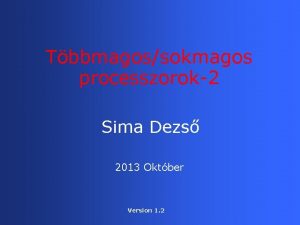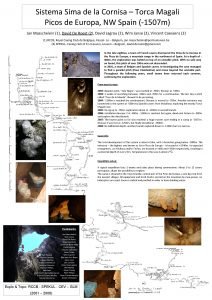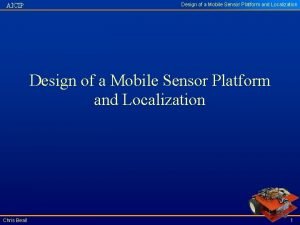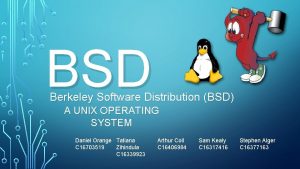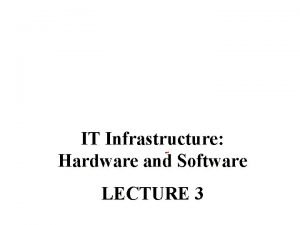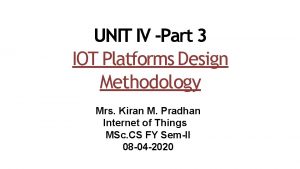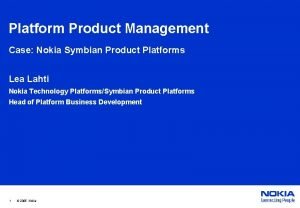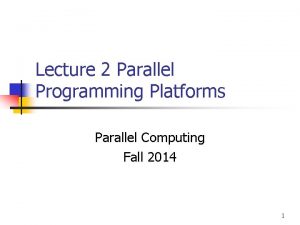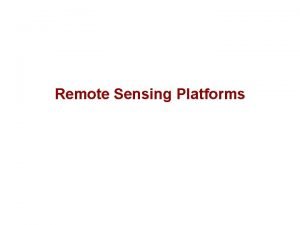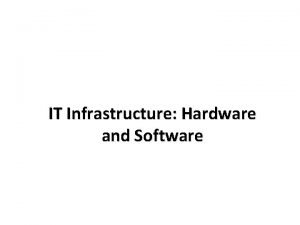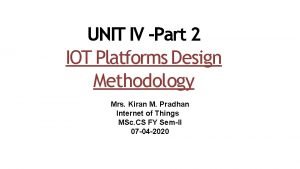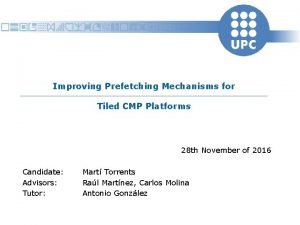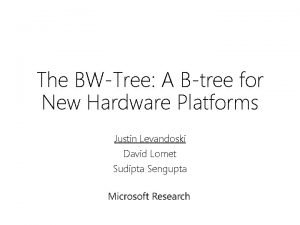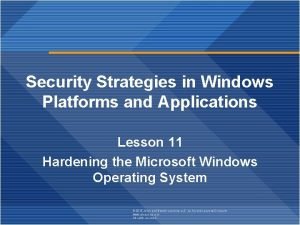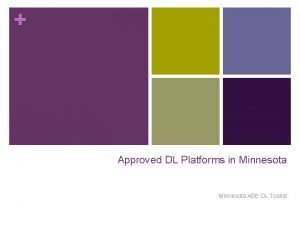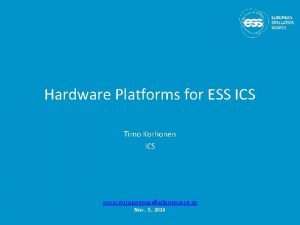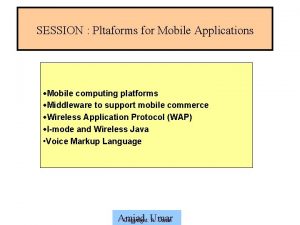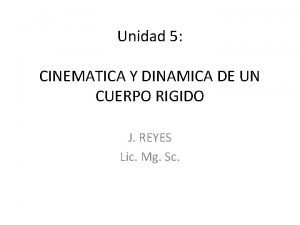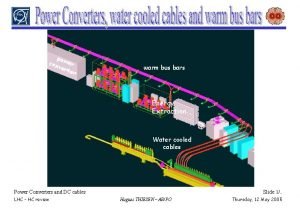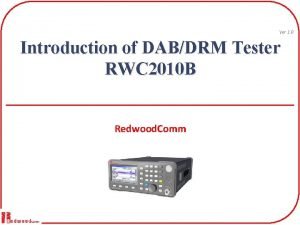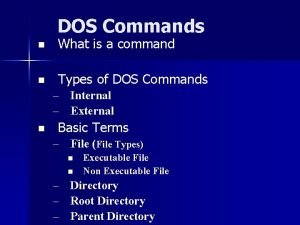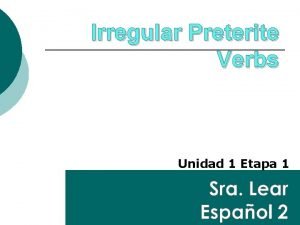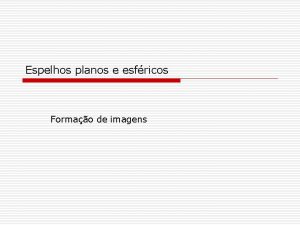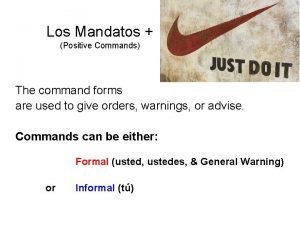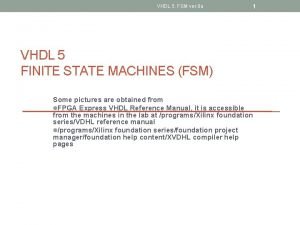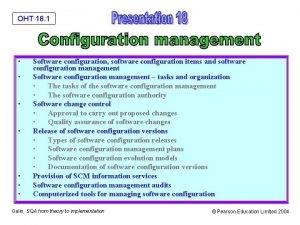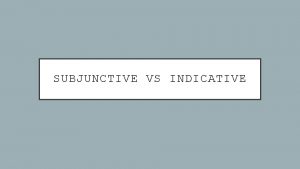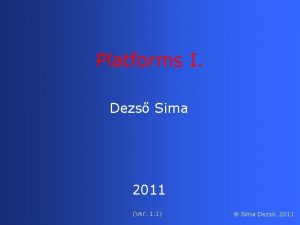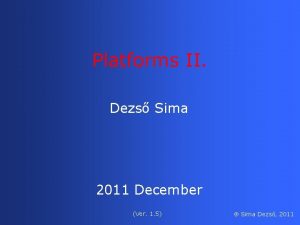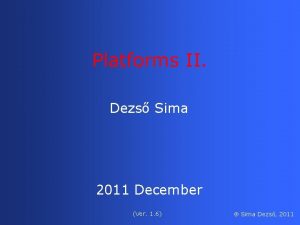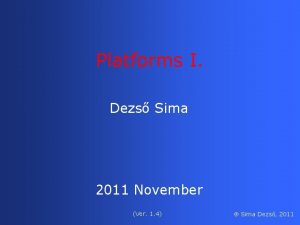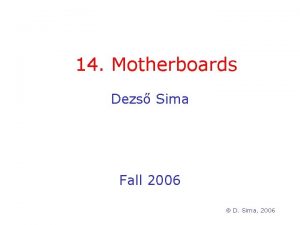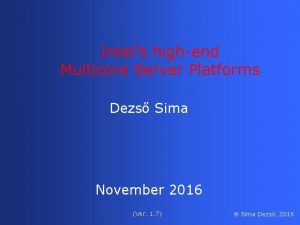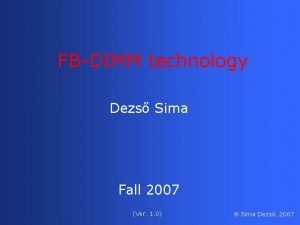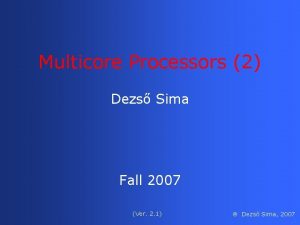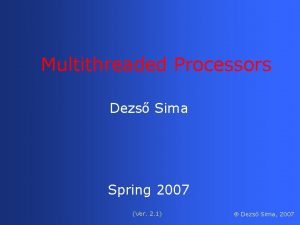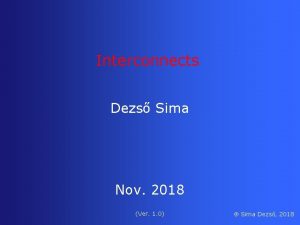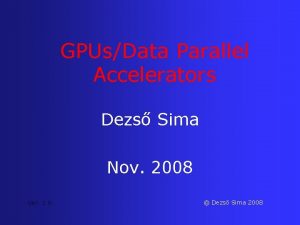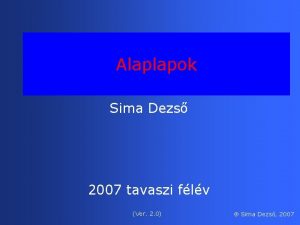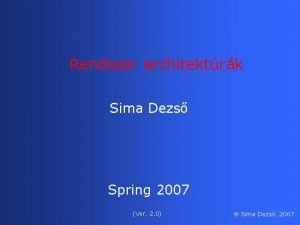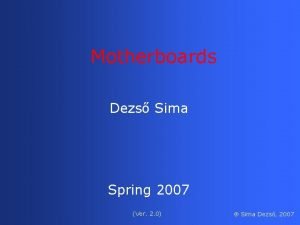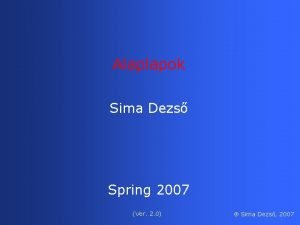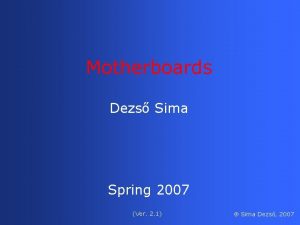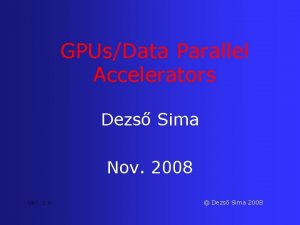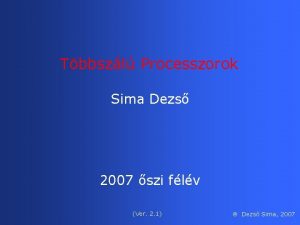Platforms I Dezs Sima 2012 Mai Ver 1









































































![2. 3. 2. 2 Memory type (14) Green and ultra-low power memories- Examples [13] 2. 3. 2. 2 Memory type (14) Green and ultra-low power memories- Examples [13]](https://slidetodoc.com/presentation_image_h/f94ec6d8507e31ff0115d132d89df6ee/image-74.jpg)







![2. 3. 2. 2 Memory type (21) The architecture of FB-DIMM memories [19] 2. 3. 2. 2 Memory type (21) The architecture of FB-DIMM memories [19]](https://slidetodoc.com/presentation_image_h/f94ec6d8507e31ff0115d132d89df6ee/image-82.jpg)







![2. 3. 2. 2 Memory type (29) Latency [22] • Due to their additional 2. 3. 2. 2 Memory type (29) Latency [22] • Due to their additional](https://slidetodoc.com/presentation_image_h/f94ec6d8507e31ff0115d132d89df6ee/image-90.jpg)



















![5. References (1) [1]: Wikipedia: Centrino, http: //en. wikipedia. org/wiki/Centrino [2]: Industry Uniting Around 5. References (1) [1]: Wikipedia: Centrino, http: //en. wikipedia. org/wiki/Centrino [2]: Industry Uniting Around](https://slidetodoc.com/presentation_image_h/f94ec6d8507e31ff0115d132d89df6ee/image-110.jpg)
![5. References (2) [11]: Ng P. K. , “High End Desktop Platform Design Overview 5. References (2) [11]: Ng P. K. , “High End Desktop Platform Design Overview](https://slidetodoc.com/presentation_image_h/f94ec6d8507e31ff0115d132d89df6ee/image-111.jpg)
![5. References (3) [20]: „Introducing FB-DIMM Memory: Birth of Serial RAM? , ” PCStats, 5. References (3) [20]: „Introducing FB-DIMM Memory: Birth of Serial RAM? , ” PCStats,](https://slidetodoc.com/presentation_image_h/f94ec6d8507e31ff0115d132d89df6ee/image-112.jpg)
- Slides: 112

Platforms I. Dezső Sima 2012 Mai (Ver. 1. 5) Sima Dezső, 2012

Contents • 1. Introduction to platforms • 2. Main components of platforms • 3. Platform architectures • 4. Memory subsystem design considerations • 5. References

1. Introduction to platforms • 1. 1. The notion of platform • 1. 2. Description of particular platforms • 1. 3. Representation forms of platforms • 1. 4. Compatibility of platform components

1. 1. The notion of platform

1. 1 The notion of platform (1) 1. 1 The notion of platform The notion platform is widely used in different segments of the IT industry e. g. by IC manufacturers, system providers or even by software suppliers with different interpretations. Here we are focusing on the platform concept as used typically by system providers. System providers however, may use the notion platform either in a more general or a more specific sense. Interpretation of the notion platform Interpretation in a more general sense Modular system design Interpretation in a more specific sense A particular modular system architecture, developed for a given application area. such as a DT or MP platform

1. 1 The notion of platform (2) Interpretation the notion platform in a more general sense Modular system design means that the system architecture is partitioned to a small number of standard components (modules), such as the processor, memory control hub (MCH), I/O control hub (ICH) that are interconnected by specified (standard) interconnections. Core 2 Duo Core 2 Extreme (2 C) FSB 965 Series MCH FSB: 1066/800/533 MT/s speed ME Two memory channels DDR 2 -800/666/533 Two DIMMs per channel C-link DMI ICH 8 Intel’s Core 2 Duo (and Core 2 Extreme (the highest speed model) aimed DT platform (the Bridge Creek platform)

1. 1 The notion of platform (3) Remark The need for a modular system design, arose in the PC industry in the time when PCI-based system designs were substituted by port based system designs, about 1998 -1999.

1. 1 The notion of platform (4) Pentium II/ Pentium III Processor bus AGP System controller Main Memory Processor bus AGP (EDO/SDRAM) 2 x. IDE/ ATA 33/66/100 Hub interface LPC PCI bus 2 x. IDE/ATA 33/66 2 x. USB 2 x/4 x USB Peripheral controller PCI device adapter Main Memory (SDRAM) North Bridge South Bridge Super I/O (KBD, MS, etc. ) AC'97 (Legacy and/or slow devices) PCI bus ISA bus PCI to ISA bridge PCI device adapter ISA bus ISA device adapter Late PCI-based system architecture (~ 1998) (used typically with Pentium II/III (built around Intel’s 440 xx chipset) Legacy devices Early port-based system architecture (~ 1999) (used first with Pentium III (built around Intel’s 810 chipset)

1. 1 The notion of platform (5) The primary goals of introducing modular system designs are • to reduce the complexity of designing complex systems by partitioning it • to minimize design rework while moving from one processor generation to the next, i. e. while enhancing system components (such as processors) upward compatible as long as the same interfaces (e. g. an FSB with a given max. frequency) are used, • to use stable interfaces in the system design, and thus • to shorten the development cost and time to market of products. Co-design of platform components Platform components are typically co-designed, announced and delivered as a set.

1. 1 The notion of platform (6) Interpretation the notion platform in a more specific sense In a more specific sense the notion platform refers to a particular modular system architecture, that is developed for a given application area, such as a DT, DP or MP platform. In this sense the platform consists of • basic system modules, such as • the processor or processors, • the chipset, • the memory subsytem and • in some cases, such as in mobile or business oriented DT platforms also the LAN controller will be considered as a basic system module [7], as well as • buses interconnecting basic system modules of the platform • and I/O-interfaces, such as interfaces to hard disc, graphics card, including also interfaces to audio/video devices, such as external displays, TV, home cinema etc. Basic components of a platform Processor or processors Chipset The memory subsystem (LAN controller) Buses interconnecting basic modules I/O-interfaces Subsequently, we will focus on the interpretation of the notion platform in this latter sense.

1. 1 The notion of platform (7) Example 1: Intel’s Core 2 aimed home user DT platform (Bridge Creek) [3] Platform 1066 MT/s Display card 2 DIMMs/channel C-link

1. 1 The notion of platform (8) Example 2: Intel’s Nehalem-EX aimed Boxboro-EX MP server platform, assuming 1 IOH Platform Xeon 7500 (Nehalem-EX) (Becton) 8 C / Xeon 7 -4800 (Westmere-EX) 10 C SMB SMB Nehalem-EX 8 C Westmere-EX 10 C QPI SMB SMB QPI QPI SMB SMB Nehalem-EX 8 C Westmere-EX 10 C QPI DDR 3 -1067 SMB SMB QPI 2 x 4 SMI channels 7500 IOH ESI ICH 10 ME DDR 3 -1067 SMI: Serial link between the processors and SMBs SMB: Scalable Memory Buffer Parallel/serial conversion ME: Management Engine

1. 1 The notion of platform (9) The structure of a platform is termed as its architecture (or topology). It describes the basic components and their interconnections and will be discussed in Section 3.

1. 1 The notion of platform (10) Many facets of the platform concept The platform concept as seen from the point of view of the manufacturers • With the platform concept in mind manufacturers, like Intel or AMD will plan, design and market all key components of a platforms, such as the processor or the processors and the related chipset as an integrated entity [5]. • This is benefitial for the manufacturers since it motivates OEMs as system providers, to buy all key parts of a computer system from the same manufacturer.

1. 1 The notion of platform (11) The platform concept as seen from the point of view of the customers The platform concept is benefitial for the customers, such as OEMs or individual buyers, since a tested and validated system architecture by the same supplier promises a more reliable and cost effective system.

1. 1 The notion of platform (12) Historical remarks System providers began using the notion “platform” about 2000, like • Philips’ Nexperia digital video platform (1999), • Texas Intruments (TI) OMAP platform for SOCs (2002), • Intel’s first generation mobile oriented Centrino platform for laptops, designated as the Carmel platform (3/2003). Intel contributed significantly for spreading the notion platform when based on the success of their Centrino platform they introduced this concept also for their desktops [5] and servers [6], [7] in 2004.

1. 1 The notion of platform (13) Intel’s early server and workstation roadmap from Aug. 2004 [6] Note a) This roadmap already makes use of the notion platform but in the sense: chipset. b) In 2004 Intel made a transition from 32 bit systems to 64 bit systems.

1. 1 The notion of platform (14) Intel’s multicore platform roadmap announced at the IDF Spring 2005 [8] Note This roadmap interprets the notion platform as a set of processor and chipset, and includes already particular platform designations for desktops, UP servers etc.

1. 2. Description of a particular platform

1. 2 Description of a particular platform (1) Description of a particular platform (Here we neglect I/O interfaces providing connection to peripheral devices or I/O) Description of a particular platform Specification of the platform architecture Example: The Tylersburg DT platform (2008) Processor MCH ICH

1. 2 Description of a particular platform (2) Specification of the platform architecture includes the specification how the basic components, such as the processor-, the memory- and the I/O subsystems are connected to each other (to be discussed in Section 3). Example: The Tylersburg DT platform (2008) Processor MCH It is concerned with issues, such as • whether the processors of an MP server are connected to the MCH via an FSB or otherwise, • whether the memory is attached to the system architecture through the MCH or through the processors etc. ), • and how the I/O system is attached.

1. 2 Description of a particular platform (3) Description of a particular platform Specification of the platform architecture Identification of the platform components Example: The Tylersburg DT platform (2008) Processor 1. gen. Nehalem (4 C)/ Westmere-EP (6 C) MCH X 58 IOH ICH 10

1. 2 Description of a particular platform (4) Description of a particular platform Specification of the platform architecture Identification of the platform components Specification of the interfaces interconnecting the platform components Example: The Tylersburg DT platform (2008) Processor 1. gen. Nehalem (4 C)/ Westmere-EP (6 C) QPI MCH X 58 IOH DMI ICH 10

1. 2 Description of a particular platform (5) Remark The specification of a platform will be completed by the datasheets of the related platform components.

1. 2 Description of a particular platform (6) Dependence of the platform architecture on the platform category Platforms may be classified according to the target area of application, such as Platform category Mobile platforms Desktop (DT) platforms Dual processor (DP) platforms Quad processor (MP) platforms Of course, beyond the above categories also further processor categories and related platforms exist, such as embedded processors and related platforms. In conformity with different platform categories also different platform architectures arise, as indicated below. Platform architecture Architecture of mobile platforms Architecture of DT platforms Architecture of DP platforms Architecture of MP platforms

1. 3. Representation forms of platforms

1. 3 Representation forms of platforms (1) 1. 3 Representation forms of platforms a) Thumbnail representation b) Block diagram of a platform. c) Descriptive representation (an arbitrarily chosen representation form in these slides)

1. 3 Representation forms of platforms (3) a) Thumbnail representation It is a concise representation of a particular platform. In particular, the thumbnail representation • reveals the platform topology, • identifies the basic components of a platform, such as the processor or processors, the chipset, in some cases (e. g. in mobile platforms) also the Gigabit Ethernet controller, • and specifies the interconnection links (buses) between the platform components. Example Core 2 Duo Core 2 Extreme (2 C) FSB: 1066/800/566 MT/s speed FSB 965 Series MCH ME Two DDR 2 channels DDR 2 -800/666/566 Two DIMMs per channel C-link DMI ICH 8 Intel’s Core 2 Duo aimed home user oriented platform (The bridge Creek platform)

1. 3 Representation forms of platforms (8) b) Block diagram of a platform It includes also the I/O-interfaces. Example: The Core 2 aimed home user DT platform (Bridge Creek) (without an integrated display controller) [3] 1066 MT/s Display card 2 DIMMs/channel C-link

1. 3 Representation forms of platforms (4) 6/2006 c) Descriptive representation DT platform Bridge Creek This kind of representation • indicates a few additional data of the processor and the chipset, DP cores (like data of the die, the cache system or the memory) • reveals the dates of the introduction of platform components, and • identifies compatibility ranges of processors or chipsets in platforms by encircling compatible components, • but lacks the graphical representation of the platform. 7/2006 E 6 xxx/E 4 xxx X 6800 (Conroe: E 6 xxx/X 6800)1 Allendale: E 4 xxx)1 Core 2 Extreme 2 C Core 2 Duo 2 C 65 nm Conroe: 291 mtrs/143 mm 2 Allendale: 167 mtrs/111 mm 2 Conroe: 4 MB/Allendale 2 MB L 2 X 6800/E 6 xxx: 1066 MT/s E 4 xxx: 800 MT/s LGA 775 6/2006 MCH 965 Series (Broadwater) FSB 1066/800/566 MT/s 2 DDR 2 channels DDR 2 -800/666/533 4 ranks/channel 8 GB max. 6/2006 ICH 8 1 The Allendale is a later stepping (Steppings L 2/M 0) of the Core 2 (Steppings B 2/G 0), that provided typically only 2 MB L 2 and appeared 1/2007. Core 2 -aimed (65 nm)

1. 3 Representation forms of platforms (5) 6/2006 Example for stating the compatibility range of a platform DT platform The Core 2 Duo aimed DT platform that targets home users (designated as the Bridge Creek platform). 7/2006 Core 2 Duo (2 C) Core 2 Extr. (2 C) DT core Core 2 Duo Core 2 Extreme (2 C) 965 Series MCH Core 2 Duo (2 C): E 6 xxx/E 4 xxx Core 2 Extreme (2 C): X 6800 E 6 xxx/X 68001: Conroe E 4 xxx)1: Allendale 65 nm Conroe: 291 mtrs/143 mm 2 Allendale: 167 mtrs/111 mm 2 Conroe: 4 MB/Allendale 2 MB L 2 X 6800/E 6 xxx: 1066 MT/s E 4 xxx: 800 MT/s LGA 775 6/2006 FSB: 1066/800/566 MT/s speed FSB ME Two DDR 2 channels DDR 2 -800/666/566 Two DIMMs per channel C-link DMI MCH ICH 8 Beyond the target processor this platform may be used also with • the previous Pentium D/EE and Pentium 4 6 x 0/6 x 1/EE and • the subsequent Core 2 Quad lines of processors, as shown in the next slides. Bridge Creek ICH Allendale is a later stepping (Steppings L 2/M 0) of the Core 2 (Steppings B 2/G 0), that provided typically only 2 MB L 2 and appeared 1/2007. 965 Series (Broadwater) FSB 1066/800/566 MT/s 2 DDR 2 channels DDR 2 -800/666/533 4 ranks/channel 8 GB max. 6/2006 ICH 8 1 The Core 2 -aimed (65 nm)

1. 3 Representation forms of platforms (6) 6/2006 Support of Pentium 4/D/EE processors Bridge Creek 5/2005 2/2005 DT cores Pentium D/EE 8 xx 1 Pentium 4 6 x 0/6 x 1/EE 1/2006 Pentium D/EE 9 xx 2, 3 (Prescott-2 M) 1 C (Smithfield) 2 x 1 C (Presler) 2 x 1 C 90 nm 169 mtrs 135 mm 2 2 MB L 2 800 MT/s Two-way multithreading LGA 775 90 nm 2 x 115 mtrs 2 x 103 mm 2 2 x 1 MB L 2 800/533 MT/s No multithreading LGA 775 65 nm 2 x 188 mtrs 2 x 81 mm 2 2 x 2 MB L 2 1066/800 MT/s No multithreading LGA 775 MCH 7/2006 Core 2 Duo (2 C) Core 2 Extr. (2 C) Core 2 Duo (2 C): E 6 xxx/E 4 xxx Core 2 Extreme (2 C): X 6800 E 6 xxx/X 68001: Conroe E 4 xxx)1: Allendale 65 nm Conroe: 291 mtrs/143 mm 2 Allendale: 167 mtrs/111 mm 2 Conroe: 4 MB/Allendale 2 MB L 2 X 6800/E 6 xxx: 1066 MT/s E 4 xxx: 800 MT/s LGA 775 6/2006 965 Series 1 Pentium EE 840 supports only 800 MT/s D 9 xx support only 800 MT/s 3 Pentium EE 955/965 supports only 1066 MT/s 2 Pentium ICH Supports also Pentium 4 6 x 0/6 x 1/EE processors/90 nm (Broadwater) FSB 1066/800/566 MT/s 2 DDR 2 channels DDR 2 -800/666/533 4 ranks/channel 8 GB max. 6/2006 ICH 8 Supports also Pentium D/EE processors/90/65 nm Core 2 -aimed (65 nm)

1. 3 Representation forms of platforms (7) 6/2006 Support of Core 2 Quad processors) DT platform Bridge Creek 7/2006 DT core Core 2 Duo (2 C) Core 2 Extr. (2 C) Core 2 Duo (2 C): E 6 xxx/E 4 xxx Core 2 Extreme (2 C): X 6800 E 6 xxx/X 68001: Conroe E 4 xxx)1: Allendale 65 nm Conroe: 291 mtrs/143 mm 2 Allendale: 167 mtrs/111 mm 2 Conroe: 4 MB/Allendale 2 MB L 2 X 6800/E 6 xxx: 1066 MT/s E 4 xxx: 800 MT/s LGA 775 6/2006 MCH 11/2006 Core 2 Quad (2 x 2 C): Q 6 xxx: Kentsfield 65 nm 2 x 291 mtrs/2 x 143 mm 2 2*4 MB L 2 1066 MT/s LGA 775 965 Series (Broadwater) FSB 1066/800/566 MT/s 2 DDR 2 channels DDR 2 -800/666/533 4 ranks/channel 8 GB max. 6/2006 ICH 8 Core 2 -aimed (65 nm) Supports also Core 2 Quad processors/65 nm

1. 4. Compatibility of platform components

1. 4 Compatibility of platform components (1) 1. 4 Compatibility of platform components One of the goals of platform based designs is to use stabilized interfaces (at least for a while) to minimize or eliminate design rework while moving from one processor generation to the next [2]. Consequently, assuming a modular designs, platform components, such as processors or chipsets of a given line are typically compatible with their previous or subsequent generations as long as the same interfaces are used and interface parameters (such FSB speed) or other implementation requirements (either from side of the components to be substituted or the substituting components) do not restrict this.

1. 4 Compatibility of platform components (2) Limits of compatibility In the discussed DT platform the target processor is the Core 2, that is connected to the MCH by an FSB with 1066/800/533 MT/s. The target processor of the platform however, can be substituted • either by processors of three previous generations or • processors of the subsequent generation (Core 2 Quad) since all these processors have FSBs of 533/800/1066 MT/s, as shown before. Core 2 Duo Core 2 Extreme (2 C) FSB: 1066/800/533 MT/s 965 Series MCH ME Two memory channels DDR 2 -800/666/533 Two DIMMs per channel C-link DMI ICH 8 Nevertheless, The highest performance level Core 2 Quad, termed as the Core 2 Extreme Quad, provided already an increased FSB speed of 1333 MT/s and therefore was not more supported by the Core 2 aimed platform considered.

2. Basic components of platforms • 2. 1. Processors • 2. 2. Buses interconnecting platform components • 2. 3. The memory subsystem

1. 1 The notion of platform (6) Basic components of platforms - Overview As already discussed in Section 1. the notion platform is interpreted as the system architecture developed for a given application area that is built up typically of • • the processor or processors, the chipset, the memory subsystem (MSS) in some cases, such as in mobile or business oriented DT platforms also the LAN-controller is considered as a basic system module [7], • buses interconnecting the system modules as well as • I/O-interfaces. Basic components of a platform Processor or processors Chipset The memory subsystem (LAN controller) Buses interconnecting the basic modules I/O-interfaces Subsequently, we will discuss the following three basic components of platforms: • Processors (Section 2. 1) • Buses interconnecting platform components (excluding memory buses) (Section 2. 2) and • The memory subsystem (Section 2. 3).

2. 1. Processors

2. 1 Processors (1) 2 YEARS TICK TOCK Pentium 4 /Northwood 2 YEARS TICK TOCK 2 YEARS Intel’s Tick-Tock model TICK TOCK Pentium 4 /Willamette Pentium 4 /Prescott Key microarchitectural features 180 nm 11/2000 New microarch. 130 nm 01/2002 Adv. microarch. , hyperthreading 90 nm 02/2004 Adv. microarch. , hyperthreading, 64 -bit TICK Pentium 4 / Cedar Mill TOCK Core 2 65 nm 01/2006 07/2006 New microarch. , 4 -wide core, 128 -bit SIMD, no hyperthreading 11/2007 11/2008 New microarch. , hyperthreading, (inclusive) L 3, integrated MC, QPI 01/2010 01/2011 New microarch. hyperthreading, 256 -bit AVX, integr. GPU, ring bus, Figure 2. 1: Overview of Intel’s Tick-Tock model (based on [17])

2. 1 Processors (2) Basic architectures and their related shrinks Considered from the Pentium 4 Prescott (the third core of Pentium 4) on Basic architectures Pentium 4 (Prescott) Core 2 Nehalem Sandy Bridge Basic architectures and their shrinks 2005 90 nm Pentium 4 2006 65 nm Core 2 2007 45 nm Penryn 2008 45 nm Nehalem 2010 32 nm Westmere 2011 32 nm Sandy Bridge 2012 22 nm Ivy Bridge

2. 1 Processors (4) In 2003 Intel shifted the focus of their processor development from the performance goal to the aspect of performance per watt, as stated in a slide from 4/2006, see below. Figure 2. 3: Intel’s plan to develop their manufacturing technology and processor lines revealed at a shareholder’s meeting back in 4/2006 [18]

2. 1 Processors (5) Basic Arch. Core 2 Penryn 1. G. Nehalem-EP 2. G. Nehalem-EP Westmere-EP Sandy Bridge Techn. Core/technology Cores Intro. Cache arch. Interf. 4 MB L 2/2 C 2/4 MB L 2/2 C 4 MB L 2/2 C 4 MB l 2/2 C FSB 65 nm X 6800 E 6 xxx E 4 xxx E 6 xxx QX 67 xx Q 6 xxx Conroe Allendale Kentsfield 2 C 2 C 2 x 2 C 2*2 C 7/2006 1/2007 7/2007 11/2006 1/2007 45 nm E 8 xxx E 7 xxx QX 9 xxx Q 8 xxx Wolfdale-3 M Yorkfield XE Yorkfield-6 M Yorkfield-4 M 2 C 2 C 2 x 2 C 2*2 C 2 x 2 C 1/2008 4/2008 11/2007 1/2008 8/2008 i 7 -920 -965 Bloomfield 4 C 11/2008 ¼ MB L 2/C, 8 MB L 3 QPI i 7 -8 xxx/i 5 -7 xx Lynnfield 4 C 9/2009 ¼ MB L 2/C, 8 MB L 3 DMI 32 nm i 7 -9 xx. X i 7 -9 xx i 5 -6 xx/i 3 -5 xx Gulftown Clarkdale 6 C 6 C 2 C+G 3/2010 7/2010 1/2010 ¼ MB L 2/C, 12 MB L 3 ¼ MB L 2/C, max. 4 MB L 2 QPI DMI 32 nm i 7 -26/27/28/29 xx i 5 -23/24/25 xx Sandy Bridge i 3 -21/23 xx 2/4 C+G 2 C+G 1/2001 1/2011 ¼ MB L 2/C, 4/8 MB L 3 ¼ MB L 2/C, 3/6 MB L 3 ¼ MB L 2/C, 3 MB L 3 DMI 2 45 nm 6 3 6 6 3 2 MB MB MB L 2/2 C L 2/2 C Table 2. 1: Intel’s Core 2 based and subsequent multicore DT processor lines FSB

2. 1 Processors (6) Basic Arch. Core/technology DP server processors Pentium 4 90 nm 10/2005 Paxville DP 2. 8 2 x 1 C, 2 MB L 2/C Pentium 4 65 nm 5/2006 5000 (Dempsy) 2 x 1 C, 2 MB L 2/C Core 2 65 nm 6/2006 11/206 5100 (Woodchrest) 5300 (Clowertown) 1 x 2 C, 4 MB L 2/C 2 x 2 C, 4 MB L 2/C Penryn 45 nm 11/2007 5400 (Harpertown) 2 x 2 C, 6 MB L 2/2 C Nehalem-EP 45 nm 3/2009 5500 (Gainstown) Westmere-EP 32 nm 3/2010 56 xx (Gulftown) 1 x 6 C, ¼ MB L 2/C 12 MB L 3 Nehalem-EX 45 nm 3/2010 6500 (Beckton) 1 x 8 C, ¼ MB L 2/C, 24 MB L 3 Westmere-EX 32 nm 4/2011 E 7 -28 xx (Westmere-EX) Sandy Bidge 32 nm 1/2011 Ivy Bridge 22 nm 11/2012? Pentium 4 (Prescott) Core 2 1 x 4 C, ¼ MB L 2/C 8 MB L 3 Nehalem 1 X 10 C, ¼ MB L 2/C 30 MB L 3 Sandy Bridge Table 2. 2: Overview of Intel’s multicore DP server processors

2. 1 Processors (7) Basic Arch. Core/technology MP server processors Pentium 4 90 nm 11/2005 Paxville MP 2 x 1 C, 2 MB L 2/C Pentium 4 65 nm 8/2006 7100 (Tulsa) Core 2 65 nm 9/2007 7200 (Tigerton DC) 7300 (Tigerton QC) 1 x 2 C, 4 MB L 2/C 2 x 2 C, 4 MB L 2/C Penryn 45 nm 9/2008 7400 (Dunnington) 1 x 6 C, 3 MB L 2/2 C 16 MB L 3 Nehalem-EP 45 nm Westmere-EP 32 nm Nehalem-EX 45 nm 3/2010 7500 (Beckton) 1 x 8 C, ¼ MB L 2/C 24 MB L 3 Westmere-EX 32 nm 4/2011 Sandy Bidge 32 nm /2011 Ivy Bridge 22 nm 11/2012 Pentium 4 (Prescott) Core 2 2 x 1 C, 1 MB L 2/C 16 MB L 3 Nehalem E 7 -48 xx (Westmere-EX) 1 x 10 C, ¼ MB L 2/C 30 MB L 3 Sandy Bridge Table 2. 3: Overview of Intel’s multicore MP server processors

2. 2. Buses interconnecting platform components

2. 2 Buses interconnecting platform components (1) 2. 2 Buses interconnecting platform components Example Use of serial buses in Intel’s Boxboro-EX DP platforms Buses interconnecting processors (In NUMA topologies) Buses interconnecting processors to chipsets Xeon 6500 (Nehalem-EX) (Becton) SMB SMB Nehalem-EX (8 C) Westmere-EX (10 C) SMB SMI links Buses interconnecting MCHs to ICHs (In 2 -part chipsets) Xeon E 7 -2800 or (Westmere-EX) QPI Nehalem-EX (8 C) Westmere-EX (10 C) QPI DDR 3 -1067 7500 IOH ESI ICH 10 SMB SMB SMI links DDR 3 -1067 ME SMI: Serial link between the processor and the SMB: Scalable Memory Buffer with Parallel/serial conversion ESI: Enterprise Southbridge Interface Nehalem-EX aimed Boxboro-EX scalable DP server platform (for up to 10 cores) Remark Buses connecting the memory subsystem with the main body of the platforms are memory specific interfaces and will be discussed in Section 4.

2. 2 Buses interconnecting platform components (2) Implementation of buses used in Intel’s DT/DP and MP platforms Parallel/serial bus Parallel bus 64 -bit wide Serial bus (Point-to-point interconnection) 8 -bit wide Used to interconnect MCHs to ICHs processors to chipsets in previous platforms FSB (Front Side Bus) HI 1. 5 16 -bit wide 4 -bit wide (4 PCIe lanes) Used to interconnect processors to processors and processors to chipsets Used to interconnect processors to chipsets or MCHs to ICHs QPI (Quick Path Interconnect) QPI 1. 1 (Quick Path Interconnect v. 1. 1) DMI (Direct Media Interface) ESI (Enterprise System Interface) DMI 2 (Direct Media Interface 2. G. )

2. 2 Buses interconnecting platform components (3) Buses used in Intel’s DT/DP/MP platforms Parallel/serial bus Parallel bus Buses interconnecting processors (In NUMA topologies) Buses interconnecting processors to chipsets FSB (64 -bit: 1993) • 64 -bit wide • ~150 lines • 3. 2 -12. 8 GB/s total in both directions Low-cost systems Serial bus Buses interconnecting MCHs to ICHs (In 2 -parts chipsets) QPI (2008) • 20 lanes • 84 lines • 9. 6/11. 72/12. 8 GB/s in each direction • 8 -bit wide • 16 lines • 266 MB/s total in both directions High-performance systems DMI/ESI (2008)2 QPI (2008) • 4 PCIe lanes • 20 lanes • 18 lines • 84 lines • 1 GB/s/direction • 9. 6/11. 72/12. 8 GB/s in each direction DMI 2 (2011) HI 1. 5 (1999) QPI 1. 1 (2012? ) • 4 PCIe lanes Specification na. • 18 lines • 2 GB/s/direction DMI/ESI (20041) • 4 PCIe lanes • 18 lines • 1 GB/s/direction DMI 2 (2011) • 4 PCIe lanes • 18 lines • 2 GB/s/direction

2. 2 Buses interconnecting platform components (4) Remarks 1 DMI: Introduced as an interface between the MCH and the ICH first along with the ICH 6, supporting Pentium 4 Prescott processors, in 2004. 2 DMI: Introduced as an interface between the processors and the chipset first between Nehalem-EP and the 34 xx. PCH, in 2008, after the memory controllers were placed to the processor die.

2. 2 Buses interconnecting platform components (5) Signaling used in buses Signals Voltage referenced Single ended Differential S+ VREF t t Typ. voltage swings 3. 3 -5 V Signaling system used TTL (5 V) FPM/EDO LVTTL (3. 3 V) FPM/EDO SDRAM HI 1. 5 VCM S- t 200 -300 m. V 600 -800 m. V SSTL 2 (DDR) SSTL 1. 8 (DDR 2) SSTL 1. 5 (DDR 3) RSL (RDRAM) FSB LVDS PCIe QPI, DMI, ESI FB-DIMMs DRSL XDR (data) Smaller voltage swings LVDS: (D)RSL: VCM: Low Voltage Differential Signaling (Differential) Rambus Signaling Level Common Mode Voltage LVTTL: SSTL: V REF: Low Voltage TTL Stub Series Terminated Logic Reference Voltage Figure 2. 4: Signal types used in MMs for control, address and data signals

2. 2 Buses interconnecting platform components (6) Main features of parallel buses used in Intel’s MC platforms FSB HI 1. 5 Typical use Connecting the processors and the chipset Connecting MCH and ICH Introduced With the Pentium (1993) With the Pentium III (1999) Width 64 bit 8 bit Clock 100 -400 MHz 66 MHz QDR since Pentium 4 (2000) QDR 400 -1600 MT/s 266 MT/s 3. 2 -12. 8 GB/s in both directions altogether 266 MB/s in both directions altogether Voltage referenced data signals Single-ended data signals ~ 150 lines ~ 16 lines DDR/QDR Transfer rate Bandwidth Signaling No. of lines FSB/HI 1. 5: Bus type interconnects

2. 2 Buses interconnecting platform components (7) Main features of serial buses used in Intel’s MC platforms DMI/ESI Typical use DMI 2 To interconnect MCHs and ICHs or processors to chipsets in NUMA platforms QPI 1. 1 To interconnect processors in NUMA topologies or processors to chipsets In connection with 2. gen. Nehalem in 2008 In connection with Sandy Bridge in 2011 In connection with Nehalem-EP in 2008 In connection with Sandy Bridge in 2012 (? ) Width 4 PCI lanes 4 PCI 2 lanes 20 lanes No specification available yet Clock 2. 5 GHz 2. 4/2. 93/3. 2 GHz DDR – – DDR 10 bit/8 bit no 1 GB/s 2 GB/s 9. 6/11. 72/12. 8 GB/s LVDS 18 lines 84 lines Introduced Encoding Bandwidth/ direction Signaling No. of lines DMI/QPI: Point-to-point interconnection

2. 2 Buses interconnecting platform components (8) Comparing main features of Intel’s FSB and QPI [9] GTL+: A kind of voltage refenced signaling

2. 2 Buses interconnecting platform components (9) Principle of LVDS signal transmission used in serial buses Figure 2. 5: LVDS Single Link Interface Circuit [10]

2. 2 Buses interconnecting platform components (10) PCIe package format (data frames) PCI Express Data Frame [10] The related fields are: Field Interpretation Frame 1 -byte Start-of-Frame/End of Frame Seq# 2 -byte Sequence Number Header 16 - or 20 -byte Header Data 0 -4096 -byte Data field CRC 4 byte ECRC (End-to-End CRC) + 4 -byte LCRC (Link CRC) (CRC: Cyclic Redundancy Check)

2. 2 Buses interconnecting platform components (11) Principle of the Quick. Path Interconnect bus (QPI bus) TX Unidirectional link RX Unidirectional link 16 data 2 protocol 2 CRC Figure 2. 6: Signals of the Quick. Path Interconnect bus (QPI-bus) [11]

2. 3. The memory subsystem • 2. 3. 1. Key parameters of the memory subsystem • 2. 3. 2. Main attributes of the memory technology used • 2. 3. 2. 1. Overview: Main attributes of the memory technology used • 2. 3. 2. 2. Memory type • 2. 3. Speed grades • 2. 3. 2. 4. DIMM density • 2. 3. 2. 5. Use of ECC support • 2. 3. 2. 6. Use of registering

2. 3. 1 Key performance parameters of the memory subsystem (1) 2. 3. 1 Key performance parameters of the memory subsystem This issue will be discussed in Section 4.

2. 3. 2 Main attributes of the memory technology used 2. 3. 2. 1 Overview: Main attributes of the memory technology used Memory type Section 2. 3. 2. 2 Speed grade 2. 3 DIMM density Use of ECC support Use of registering 2. 3. 2. 4 2. 3. 2. 5 2. 3. 2. 6

2. 3. 2. 2 Memory type (1) 2. 3. 2. 2 Memory type a) Overview: Main DRAM types DRAMs for general use DRAMs with parallel bus connection Asynchronous DRAM Year of intro. FP FPM EDO (1970) (~1974) (1983) (1995) Commodity DRAMs Synchronous DRAMs SDRAM (1996) DDR 2 DDR 3 DRDRAM XDR FB-DIMM (2000) (2004) (2007) (1999) (2006)1 (2006) DDR Main stream DRAM types 1 DRAMs with serial bus connection Used in the Cell BE and the Play. Station 3, but not yet in desktops or servers Challenging DRAM types

2. 3. 2. 2 Memory type (2) b) Synchronous DRAMs (SDRAM, DDR 2, DDR 3)

2. 3. 2. 2 Memory type (3) SDRAM to DDR 3 DIMMs SDRAM 168 -pin DDR 184 -pin DRAM device DDR 2 240 - pin DIMM DDR 3 All these DIMM modules are 8 -byte wide 240 -pin

2. 3. 2. 2 Memory type (4) Principle of operation of synchronous DRAMs (SDRAM to DDR 3 memory chips) DRAM device Memory Cell Array Sources/sinks data to/from the I/O buffers • at a rate of f. Cell • at a width of FW f. Cell I/O Buffers Receives/transmit data to/from the MC • at a rate of f. CK (SDRAM) or • 2 x fclock (DDR to DDR 3) f. CK Memory controller (MC) Data transmission • on the rising edge of the strobe (CK) for SDRAMs or • on both edges of the strobe (DQS) for DDR/DDR 2/DDR 3.

2. 3. 2. 2 Memory type (5) Sourcing/sinking data by the memory cell array The memory cell array sources/sinks data to/from the I/O buffers • at a rate of f. Cell, where f. Cell is the clock frequency of the memory cell aray, • at a data width of FW, where FW is the fetch width of the memory cell array. The core clock frequency of the memory cell array (fcell) • f. Cell is 100 to 200 MHz • It stands in a given ratio with the clock frequency of the memory device (f. CK) as follows: f. CK SDRAM fcore DDR 2 2 x fcore DDR 3 4 x fcore Raising f. Cell from 100 MHz to 200 MHz characterizes the evolution of each memory technology • When a new memory technology (e. g. DDR 2 or DDR 3) appears f. Core is initially 100 MHz, . this sets the initial speed grade of f. CK accordingly (e. g. to 400 MT/s for DDR 2 or to 800 MT/s for DDR 3). • As memory technology evolves f. Core will be raised from 100 MHz to 133, 167 and to 200 MHz. • Along with f. Core f. CK and the final speed grade will also be raised.

2. 3. 2. 2 Memory type (6) The fetch width (FW) of the memory cell array It specifies how many times more bits the cell array fetches per column cycle then the data width of the device (xn). E. g. a 4 -bit wide DRAM device (x 4 DRAM chip) with a fetch width of 4 (actually a DDR 2 DRAM) fetches 4 × 4 that is 16 bits from the memory cell array in every f. Cell cycle. The fetch width (FW) of the memory cell array of synchronous DRAMs is as follows: DRAM type FW SDRAM 1 DDR 2 4 DDR 3 8

2. 3. 2. 2 Memory type (7) Transferring data between the I/O Buffers and the Memory Controller Data transmission between the I/O buffers and the Memory Controller is clocked by a frequency of f. CK. Data transmission occurs • for SDRAMs at the rising edge of the strobe signal (CK) • for DDR/DDR 2/DDR 3 at both edges of the strobe signal (DQS), designated as the Double Data Rate transfer) The final transfer rate (speed grade) results in • f. CK for SDRAMs • 2 x f. CK for DDR/DDR 2/DDR 3 Accordingly, typical speed grade ranges cover • • 100 200 400 800 to to 200 MT/s for SDRAM devices, 400 MT/s for DDR devices, 800 MT/s for DDR 2 devices and 1600 MT/s for DDR 3 devices.

E. g. SDRAM E. g. DDR 2 SDRAM Clock frequency (f. CK) 100 MHz DRAM core frequency 100 MHz Memory Cell Array f. Cell DRAM core clock 100 MHz Memory Cell Array n bits f. Cell 2 xn bits I/O Buffers f. CK n bits I/O Buffers 2 x f. CK n bits 4 xn bits E. g. DRAM core clock 100 MHz SDRAM-100 Data transfer on both edges of DQS over the data lines (DQ 0 - DQn-1) 200 MT/s DDR-200 Data Strobe (DQS) 200 MHz Clock (CK/CK#) 200 MHz f. Cell Data transfer on the rising edges of CK over the data lines (DQ 0 - DQn-1) 100 MT/s Data Strobe (DQS) 100 MHz Clock (CK/CK#) 100 MHz DRAM core clock 100 MHz Memory Cell Array f. CK I/O Buffers n bits Clock (CK) 100 MHz Clock (CK/CK#) 400 MHz Data transfer on both edges of DQS over the data lines (DQ 0 - DQn-1) 400 MT/s DDR 2 -400 Data Strobe (DQS) 400 MHz f. Cell DDR 3 SDRAM Memory Cell Array I/O Buffers 8 xn bits 2 x f. CK n bits Data transfer on both edges of DQS over the data lines (DQ 0 - DQn-1) 800 MT/s DDR 3 -800

2. 3. 2. 2 Memory type (9) The main technique to increase memory speed Relation between voltage swings and rise/fall times of signals Q = Cin x V = I x t Q: Cin: V: I: t. R: Smaller voltage swings t. R ~ Cin x V/I Charge on the input capacitance of the line (Cin) Input capacitance of the line Voltage Current strength of the driver Rise time shorter signal rise/fall times higher speed grades but lower voltage budget higher requirements for signal integrity Memory type SDRAM DDR 2 DDR 3 Voltage/Voltage swing 3. 3 2. 5 1. 8 1. 5 V V

2. 3. 2. 2 Memory type (10) Signaling of command, control and adress lines Single ended (TTL, LVTTL) Voltage ref. (RSL, SSTL) Differential (DRSL, LVDS) Signaling of data lines Single ended (TTL, LVTTL) Voltage ref. (RSL, SSTL) Differential (DRSL, LVDS) FPM EDO SDRAM DDR 2 DDR 3 RDRAM XDR 2 FBDIMM Figure 2. 7: Signaling alternatives of buses used with memories

2. 3. 2. 2 Memory type (11) Key features of synchronous DRAM devices (SDRAM to DDR 3) JEDEC standard Key features SDRAM DDR 2 SDRAM DDR 3 SDRAM JESD 21 -C Release 4 JESD 79 -2 JESD 79 -3 Synchronous, pipelined, burst oriented Double data rate 2 n prefetch architecture Double data rate 4 n prefetch architecture Double data rate 8 n pref. architecture JESD 21 -C Release 4 11/1993 JESD 79 6/2000 JESD 79 E 5/2005 JESD 79 -2 9/2003 JESD 79 -2 C 5/2006 JESD 79 -3 6/2007 Device density 64 Mb 128 Mb - 1 Gb 256 Mb - 4 Gb 256 Mb – 4 Gb 512 Mb – 8 Gb Organization x 4/8/16 x 4/8/16 200/266/ 333/400 400/533/ 667/800 800/1066/ 1333/1600 16 -256 Mb x 8/16 64 -512 Mb x 8/16 128 -512 Mb x 8/16 256 Mb – 1 Gb x 8/16 256 Mb -1 Gb x 8/16 512 Mb – 16 Gb Pentium III P 4 (Willamette) P 4 (Northwood) P 4 (Prescott) P 4 (Presler) Pentium D Core 2 Duo to Sandy Bridge Standard First/last release Device speed (MT/s) 66 Device density 4/16 Mb Typ. processors Pentium (3 V) Voltage No. of pins on the modul 100/133 3. 3 V 2. 5 V 1. 8 V 1. 5 V 168 184 240 Table 2. 4: Key features of synchronous DRAM devices

2. 3. 2. 2 Memory type (12) Approximate appearance dates and speed grades of DDR DRAMs as well as the bandwidth provided by a dual channel memory subsystem Bandwidth 1 1 Bandwidth of a dual channel memory subsystem [12]

2. 3. 2. 2 Memory type (13) Green and ultra-low power memories They represents the latest achievements of the DRAM memory technology Green memories: lower dissipation memories Ultra-low-power DDR 3 memories: Use of 1. 35 V supply voltage instead of 1. 50 V to reduce dissipation
![2 3 2 2 Memory type 14 Green and ultralow power memories Examples 13 2. 3. 2. 2 Memory type (14) Green and ultra-low power memories- Examples [13]](https://slidetodoc.com/presentation_image_h/f94ec6d8507e31ff0115d132d89df6ee/image-74.jpg)
2. 3. 2. 2 Memory type (14) Green and ultra-low power memories- Examples [13]

2. 3. 2. 2 Memory type (15) 8 -byte wide memory modules (DIMMs) SDRAM 168 -pin DDR 184 -pin DRAM device DDR 2 240 - pin DIMM DDR 3 240 -pin Keying (notch)

2. 3. 2. 2 Memory type (16) Types of DIMMs Single-sided/double-sided DIMMs Single-sided DIMMs DRAM devices are placed only on one DIMM side Double-sided DIMMs DRAM devices are placed on both DIMM sides Rank (logical module) • 64 data bits or 64 data + 8 ECC bits wide memory block, • all devices of a rank will be activated by the same chip select (CS) signal. DIMM (physical module) The physical carrier of ½, 1 or 2 ranks.

2. 3. 2. 2 Memory type (17) Examples for single-sided and double sided DIMMs with single or dual ranks [45] 9 x 8 -bit DDR devices

2. 3. 2. 2 Memory type (18) Example: Traditional way of attaching DIMMs via a parallel channel to the MCH [45]

2. 3. 2. 2 Memory type (18) Example 2: Attaching DIMMs via 3 parallel memory channels to memory controllers implemented on the processor die (This is actually Intel’s the Tylersburg DP platform, aimed at the Nehalem-EP processor, used for up to 6 cores) [46]

2. 3. 2. 2 Memory type (19) c) FB-DIMMs DRAMs for general use DRAMs with parallel bus connection Asynchronous DRAM Year of intro. FP FPM EDO (1970) (~1974) (1983) (1995) DRAMs with serial bus connection Synchronous DRAMs SDRAM (1996) DDR 2 DDR 3 DRDRAM XDR FB-DIMM (2000) (2004) (2007) (1999) (2006)1 (2006) DDR Main stream DRAM types 1 Used in the Cell BE and the Play. Station 3, but not yet in desktops or servers Challenging DRAM types

2. 3. 2. 2 Memory type (20) Principle of operation • Introduce packed based serial transmission (like in the PCI-E, SATA, SAS buses) • Introduce full buffering (registered DIMMs buffer only address and control signal) • CRC error checking (cyclic redundancy check)
![2 3 2 2 Memory type 21 The architecture of FBDIMM memories 19 2. 3. 2. 2 Memory type (21) The architecture of FB-DIMM memories [19]](https://slidetodoc.com/presentation_image_h/f94ec6d8507e31ff0115d132d89df6ee/image-82.jpg)
2. 3. 2. 2 Memory type (21) The architecture of FB-DIMM memories [19]

2. 3. 2. 2 Memory type (22) Figure 2. 8: Maximum supported FB-DIMM configuration [20] (6 channels/8 DIMMs)

2. 3. 2. 2 Memory type (23) Implementation details (1) • Serial (differential) transmission between the North Bridge and the DIMMs (each bit needs a pair of wires) • Number of seral links • 14 read lanes (2 wires each) • 10 write lanes (2 wires each) • Clocked at 6 x data rate of the DDR 2 e. g. for a DDR-667 DRAM the clock rate is: 6 x 667 MHz = 4 GHz • Every 12 cycles (that is every two memory cycles) constitute a packet. • Read packets (frames, bursts): 12 x 14 = 168 bits • 144 data bits (equals the number of data bits produced by a 72 bit wide DDR 2 module (64 data bits + 8 ECC bits) in two memory cycles) • 24 CRC bits. • Write packets (frames, bursts): 12 x 10 = 120 bits • 98 payload bits • 22 CRC bits.

2. 3. 2. 2 Memory type (24) Implementation details (2) 98 payload bits. • 2 frame type bits, • 24 bits of command, • 72 bits for data and commands, according to the frame type, e. g. 72 bits of data, 36 bits of data + one command or two commands. Commands • all commands include a 3 -bit FB-DIMM module address to select one of 8 modules.

2. 3. 2. 2 Memory type (25) FB-DIMM data puffer (Advanced Memory Buffer, AMB) Manages the read/write operations of the module FB-DIMM-4300 (DDR 2 -533 SDRAM); Clock Speed: 133 MHz, Data Rate: 532 MHz, Through-put 4300 MB/s FB-DIMM-5300 (DDR 2 -667 SDRAM); Clock Speed: 167 MHz, Data Rate: 667 MHz, Through-put 5300 MB/s FB-DIMM-6400 (DDR 2 -800 SDRAM); Clock Speed: 200 MHz, Data Rate: 800 MHz, Through-put 6400 MB/s Figure 2. 9: Different implementations of FB-DIMMs [48] The notch (keying) differs from DDR 2 DIMMs

2. 3. 2. 2 Memory type (26) S/P Converter Figure 2. 10: Block diagram of the AMB [21] (There are two Command/Address buses (C/A) to limit loads of 9 to 36 DRAMs)

2. 3. 2. 2 type Necessary routing to connect the north bridge to. Memory the DIMM socket (27) b) In case of an FB-DIMM (69 pins) a) In case of a DDR 2 DIMM (240 pins) A 3 -layer PCB is needed A 2 -layer PCB is needed (but a 3. layer is used for power lines) Figure 2. 11: PCB routing [19]

2. 3. 2. 2 Memory type (28) Assessing benefits and drawbacks of FB-DIMM memories (as compared to DDR 2/3 memories) Benefits of FB-DIMMs • more memory channels (up to 6) higher memory size and bandwidth • more DIMM modules (up to 8) per channel higher memory size (6 x 8=48 DIMM size) asuming 8 GB/DIMM • up to 512 GB same bandwidth figures as the parts based on (DDR 2) Drawbacks of FB-DIMMs • higher latency • higher dissipation (Typical dissipation figures: DDR 2: about 5 W AMB: about 5 W FB-DIMM with DDR 2: about 10 W) • higher cost
![2 3 2 2 Memory type 29 Latency 22 Due to their additional 2. 3. 2. 2 Memory type (29) Latency [22] • Due to their additional](https://slidetodoc.com/presentation_image_h/f94ec6d8507e31ff0115d132d89df6ee/image-90.jpg)
2. 3. 2. 2 Memory type (29) Latency [22] • Due to their additional serialization tasks and daisy-chained nature FB-DIMMs have about 15 % higher overall average latency than DDR 2 memories. Production The production of FB-DIMMs stopped with DDR 2 -800 modules, no DDR 3 modules came to the market due to the drawbacks of the technology.

2. 3 Speed grades (1) 2. 3 Speed grades Overview of the speed grades of DDR DRAMs Bandwidth 1 1 Bandwidth of a dual channel memory subsystem [12]

2. 3 Speed grades (2) Remark Speed grades of FSBs and DRAMs were defined at the time when the base clock frequency of the FSBs was 133 MHz (around 2000). Then subsequent speed grades of FSBs and also those of the memories were chosen as subsequent integral multiples of 133 MHz, such as 266 = 2 x 133 400 ~= 3 x 133 533 ~= 4 x 133 667 ~= 5 x 133 800 ~= 6 x 133 1067 ~= 7 x 1333 ~= 8 x 133 1600 ~= 9 x 133 etc.

2. 3 Speed grades (3) Rate of increasing the transfer rates in synchronous DRAMs Transfer rate (MT/s) 5000 2000 1000 500 200 100 50 SDRAM 133 SDRAM 100 * SDRAM 66 * DDR 266 * DDR 333 * DDR 400 * DDR 2 533 * DDR 2 667 * DDR 2 800 * DDR 3 1600 1333 * * ~ 10*/10 years * 20 10 Year 96 97 98 99 2000 01 02 03 04 05 06 07 08 Figure 2. 12: The evolution of peak transfer rates of parallel connected synchronous DRAMs as manifested in Intel’s chipsets

2. 3. 2. 4 DIMM density (1) 2. 3. 2. 4. DIMM density a) Device density Units 106 2000 4 M 1500 16 M 64 M 256 M 1 G Density: ~4×/4 Y 64 K 1000 500 256 K 1 M 16 K 1980 1985 1990 1995 2000 2005 2010 2015 Year Figure 2. 13: Evolution of DRAM densities (Mbit) and no. of units shipped/year (Based on [23])

2. 3. 2. 4 DIMM density (2) b) DIMM (module) density Based on • typical device densities of 1 to 8 Gb and with • typical widths of x 4 to x 16 (bits) DDR 2 or DDR 3 modules provide typical densities of up to 8 or 16 GB.

2. 3. 2. 5 Use of ECC support (1) 2. 3. 2. 5 Use of ECC support ECC basics (as used in DIMMs) Implemented as SEC-DED (Single Error Corretion Double Error Detection) Single bit Error Correction For D data bits P check-bits are added. Data bits Check bits D P Figure: The code word The minimum number of check-bits (P) for single bit error corection ? Requirement: 2 P ≥ the minimum number of states to be distinguished.

2. 3. 2. 5 Use of ECC support (2) The minimum number of states to be distinguished: • It is needed to specify the bit position of a possible single bit error in the code word consisting of both data and check bits This requires D + P states • one additional state to specify the „no error” state. the minimum number of states to be distinguished is: D + P + 1 Accordingly: to implement single bit error correction the minimum number of check bits (P) needs to satisfy the requirement: 2 P ≥ D + P + 1

2. 3. 2. 5 Use of ECC support (3) Double bit error detection an additional parity bit is needed to check for an additional error. Then the minimum number of check-bits (CB) needed for SEC-DED is: CB = P + 1 since 2 P ≥ D + P + 1 P = CB - 1 2 CB-1 ≥ D + CB -1 + 1 2 CB-1 ≥ D + CB Data bits (D) Check bits (CB) 1 2 3: 2 3 7: 4 4 15: 8 5 31: 16 6 63: 32 7 127: 64 8 255: 128 9 511: 256 10 Table 2. 5: The number of check-bits (CB) needed for D data bits

2. 3. 2. 5 Use of ECC support (4) Support of ECC and registering in DT and DP/MP platforms DT memories typically do not support ECC or registered (buffered) DIMMs, Servers make typically use of registered DIMMs with ECC protection.

2. 3. 2. 5 Use of ECC support (5) Typical implementation of ECC protected registered DIMMs (used typically in servers) Main components • Two register chips, for buffering the address- and command lines • A PLL (Phase Locked Loop) unit for deskewing clock distribution. ECC Register PLL Register Figure 2. 14: Typical layout of a registered memory module with ECC [14]

2. 3. 2. 6 Use of registering (1) 2. 3. 2. 6 Use of registering Problems arising while implementing higher memory capacities Higher memory capacities need more modules Higher loading the lines Signal integrity problems Buffering address and command lines, Phase locked clocking of the modules

2. 3. 2. 6 Use of registering (2) Registering Principle Buffering address and control lines • to reduce signal loading in a memory channel • in order to increase the number of supported DIMM slots (max. mem. capacity), needed first of all in servers,

2. 3. 2. 6 Use of registering (3) Implementation of registering By means of a register chip that buffers address and control lines R E G I S T E R REGE: Register enable signal Figure 2. 15: Registered signals in case of an SDRAM memory module [15] Note: Data (DQ) and data strobe (DQS) signals are not registered as only address an control signals are common for all memory chips.

2. 3. 2. 6 Use of registering (4) Number of register chips required • Synchronous memory modules (SDRAM to DDR 3 DIMMs) have about 20 – 30 address and control lines, • Register chips buffer usually 14 lines, Typically, two register chips are needed per memory module [16].

2. 3. 2. 6 Use of registering (5) Example: Block diagram of a registered DDR DIMM S D R A M PI 74 SSTV 168 57 Register Address/Control form Motherboard S D R A M PI 6 CV 857 PLL Input Clock for Motherboard S D R A M Data From / To Motherboard PI 74 SSTV 168 57 Register Address Control from Motherboard Figure 2. 17: Example. Block diagram of a registered DDR DIMM [16]

2. 3. 2. 6 Use of registering (6) Typical layout of registered DIMMs • Two register chips, for buffering the address- and command lines • A PLL (Phase locked loop) unit for deskewing clock distribution. ECC Register PLL Register Figure 2. 16: Typical layout of a registered memory module with ECC [14]

2. 3. 2. 6 Use of registering (7) Registered DIMM module with ECC Figure 2. 18: Registered DIMM module with ECC [14]

2. 3. 2. 6 Use of registering (9) Typical use of unregistered DIMMs (UDIMMs) in desktops/laptops (Memory capacities: up to a few GB) Typical use of registered DIMM (RDIMM) in servers (Memory capacities: a few tens of GB to a few hundreds of GB)

5. References
![5 References 1 1 Wikipedia Centrino http en wikipedia orgwikiCentrino 2 Industry Uniting Around 5. References (1) [1]: Wikipedia: Centrino, http: //en. wikipedia. org/wiki/Centrino [2]: Industry Uniting Around](https://slidetodoc.com/presentation_image_h/f94ec6d8507e31ff0115d132d89df6ee/image-110.jpg)
5. References (1) [1]: Wikipedia: Centrino, http: //en. wikipedia. org/wiki/Centrino [2]: Industry Uniting Around Intel Server Architecture; Platform Initiatives Complement Strong Intel IA-32 and IA-64 Targeted Processor Roadmap for 1999, Business Wire, Febr. 24 1999, http: //www. thefreelibrary. com/Industry+Uniting+Around+Intel+Server +Architecture%3 B+Platform. . . -a 053949226 [3]: Intel Core 2 Duo Processor, http: //www. intel. com/pressroom/kits/core 2 duo/ [4]: Keutzer K. , Malik S. , Newton R. , Rabaey J. , Sangiovanni-Vincentelli A. , System Level Design: Orthogonalization of Concerns and Platform-Based Design, IEEE Transactions on Computer-Aided Design of Circuits and Systems, Vol. 19, No. 12, Dec. 2000, pp. 1 -29. [5]: Krazit T. , Intel Sheds Light on 2005 Desktop Strategy, IDG News Service, Dec. 07 2004, http: //pcworld. about. net/news/Dec 072004 id 118866. htm [6]: Perich D. , Intel Volume platforms Technology Leadership, Presentation at HP World 2004, http: //98. 190. 245. 141: 8080/Proceed/HPW 04 CD/papers/4194. pdf [7] Powerful New Intel Server Platforms Feature Array Of Enterprise-Class Innovations. Intel’s Press release, Aug. 2, 2004 , http: //www. intel. com/pressroom/archive/releases/20040802 comp. htm [8]: Smith S. , Multi-Core Briefing, IDF Spring 2005, San Francisco, Press presentation, March 1 2005, http: //www. silentpcreview. com/article 224 -page 2 [9]: An Introduction to the Intel Quick. Path Interconnect, Jan. 2009, http: //www. intel. com/ content/dam/doc/white-paper/quick-path-interconnect-introduction-paper. pdf [10]: Davis L. PCI Express Bus, http: //www. interfacebus. com/PCI-Express-Bus-PCIe-Description. html
![5 References 2 11 Ng P K High End Desktop Platform Design Overview 5. References (2) [11]: Ng P. K. , “High End Desktop Platform Design Overview](https://slidetodoc.com/presentation_image_h/f94ec6d8507e31ff0115d132d89df6ee/image-111.jpg)
5. References (2) [11]: Ng P. K. , “High End Desktop Platform Design Overview for the Next Generation Intel Microarchitecture (Nehalem) Processor, ” IDF Taipei, TDPS 001, 2008, http: //intel. wingateweb. com/taiwan 08/published/sessions/TDPS 001/FA 08%20 IDFTaipei_TDPS 001_100. pdf [12]: Computing DRAM, Samsung. com, http: //www. samsung. com/global/business/semiconductor /products/dram/Products_Computing. DRAM. html [13]: Samsung’s Green DDR 3 – Solution 3, 20 nm class 1. 35 V, Sept. 2011, http: //www. samsung. com/global/business/semiconductor/Greenmemory/Downloads/ Documents/downloads/green_ddr 3_2011. pdf [14]: DDR SDRAM Registered DIMM Design Specification, JEDEC Standard No. 21 -C, Page 4. 20. 4 -1, Jan. 2002, http: //www. jedec. org [15]: Datasheet, http: //download. micron. com/pdf/datasheets/modules/sdram/ SD 9 C 16_32 x 72. pdf [16]: Solanki V. , „Design Guide Lines for Registered DDR DIMM Module, ” Application Note AN 37, Pericom, Nov. 2001, http: //www. pericom. com/pdf/applications/AN 037. pdf [17]: Fisher S. , “Technical Overview of the 45 nm Next Generation Intel Core Microarchitecture (Penryn), ” IDF 2007, ITPS 001, http: //isdlibrary. intel-dispatch. com/isd/89/45 nm. pdf [18]: Razin A. , Core, Nehalem, Gesher. Intel: New Architecture Every Two Years, Xbit Laboratories, 04/28/2006, http: //www. xbitlabs. com/news/cpu/display/20060428162855. html [19]: Haas, J. & Vogt P. , Fully buffered DIMM Technology Moves Enterprise Platforms to the Next Level, ” Technology Intel Magazine, March 2005, pp. 1 -7
![5 References 3 20 Introducing FBDIMM Memory Birth of Serial RAM PCStats 5. References (3) [20]: „Introducing FB-DIMM Memory: Birth of Serial RAM? , ” PCStats,](https://slidetodoc.com/presentation_image_h/f94ec6d8507e31ff0115d132d89df6ee/image-112.jpg)
5. References (3) [20]: „Introducing FB-DIMM Memory: Birth of Serial RAM? , ” PCStats, Dec. 23, 2005, http: //www. pcstats. com/articleview. cfm? articleid=1812&page=1 [21]: Mc. Tague M. & David H. , „ Fully Buffered DIMM (FB-DIMM) Design Considerations, ” Febr. 18, 2004, Intel Developer Forum, http: //www. idt. com/content/OSA-S 009. pdf [22]: Ganesh B. , Jaleel A. , Wang D. , Jacob B. , Fully-Buffered DIMM Memory Architectures: Understanding Mechanisms, Overheads and Scaling, 2007, [23]: DRAM Pricing – A White Paper, Tachyon Semiconductors, http: //www. tachyonsemi. com/about/papers/DRAM%Pricing. pdf
 Dia de pentecostes mattos nascimento
Dia de pentecostes mattos nascimento Mila nori
Mila nori Sirul numerelor naturale
Sirul numerelor naturale Reo
Reo Períptero
Períptero Sima apu
Sima apu Discontinuidades sismicas
Discontinuidades sismicas Sima qian
Sima qian Where is andy going class 5
Where is andy going class 5 Bagaimana bukti adilnya seorang ratu sima
Bagaimana bukti adilnya seorang ratu sima Sima de la cornisa
Sima de la cornisa Pirosfer
Pirosfer Sima yaqubova
Sima yaqubova Local guide program
Local guide program Caracterizare stanica ratiu
Caracterizare stanica ratiu Digitally convergent platforms
Digitally convergent platforms Security strategies in windows platforms and applications
Security strategies in windows platforms and applications Custom platforms dll
Custom platforms dll Mobile sensor platforms
Mobile sensor platforms Social media platforms
Social media platforms Berkeley system distribution
Berkeley system distribution Computer hardware platforms in it infrastructure
Computer hardware platforms in it infrastructure Which is the sixth step in iot design methodology?
Which is the sixth step in iot design methodology? Security strategies in linux platforms and applications
Security strategies in linux platforms and applications Planning for product platforms
Planning for product platforms Types of internet platforms
Types of internet platforms Parallel programming platforms
Parallel programming platforms Aerial photography platforms
Aerial photography platforms Remote sensing platforms
Remote sensing platforms Service delivery platforms
Service delivery platforms Content marketing platforms forrester
Content marketing platforms forrester Oregon trail 2001
Oregon trail 2001 Computer hardware platforms in it infrastructure
Computer hardware platforms in it infrastructure Domain model specification defines which entity
Domain model specification defines which entity Security strategies in windows platforms and applications
Security strategies in windows platforms and applications Aterm wh832
Aterm wh832 High altitude aeronautical platforms
High altitude aeronautical platforms Chapter 5 it infrastructure and emerging technologies
Chapter 5 it infrastructure and emerging technologies Security strategies in linux platforms and applications
Security strategies in linux platforms and applications Online platforms for ict content development
Online platforms for ict content development Cmp platforms
Cmp platforms Ridesharing platforms
Ridesharing platforms Btree simulation
Btree simulation Computer hardware platforms in it infrastructure
Computer hardware platforms in it infrastructure Security strategies in windows platforms and applications
Security strategies in windows platforms and applications Hazards
Hazards Dl platforms
Dl platforms Services provided by functional view specification
Services provided by functional view specification Allows users to categorize and locate information
Allows users to categorize and locate information Nmc 7 platforms
Nmc 7 platforms Ics platforms
Ics platforms How many prefixes? reconstruction
How many prefixes? reconstruction Library services platforms
Library services platforms Mobile computing platforms
Mobile computing platforms Pazarlamanın temel kavramları
Pazarlamanın temel kavramları Vengan a ver mi granja que es hermosa
Vengan a ver mi granja que es hermosa Asistir conjugation present tense
Asistir conjugation present tense Características de maseta
Características de maseta Subjunctive and indicative
Subjunctive and indicative Gocemonos amado y vamonos a ver en tu hermosura
Gocemonos amado y vamonos a ver en tu hermosura No pueden ver a un pobre acomodado
No pueden ver a un pobre acomodado Salık ver
Salık ver Qué es la inercia
Qué es la inercia Wat van ver komt is dit
Wat van ver komt is dit Mis amigos ver una película de horror anoche
Mis amigos ver una película de horror anoche A ver si recuerdas
A ver si recuerdas Doa ah
Doa ah No llores por no poder ver el sol
No llores por no poder ver el sol Beszterce ostroma szereplők jellemzése
Beszterce ostroma szereplők jellemzése Verexif
Verexif Megakaryopoiesis
Megakaryopoiesis Financiera confianza ver saldo
Financiera confianza ver saldo Nem test és vér ellen harcolunk
Nem test és vér ellen harcolunk Ver de ter
Ver de ter Regular preterite verbs
Regular preterite verbs Rwc2010b
Rwc2010b Imperfect endings
Imperfect endings Ver
Ver Hay un dios que todo lo ve y es amigo mio
Hay un dios que todo lo ve y es amigo mio Um pequeno menino queria se encontrar com deus
Um pequeno menino queria se encontrar com deus Regular preterite endings
Regular preterite endings Quiero ver videos de sexo
Quiero ver videos de sexo Ríos de la vertiente del atlántico
Ríos de la vertiente del atlántico Ver
Ver Ver claro analise do poema
Ver claro analise do poema Macario schettino biografia
Macario schettino biografia Division de palabras
Division de palabras Alguna vez has tenido la oportunidad de ver el amanecer
Alguna vez has tenido la oportunidad de ver el amanecer A ver si recuerdas
A ver si recuerdas Método ver, juzgar y actuar ejemplos
Método ver, juzgar y actuar ejemplos El último cuadro de van gogh
El último cuadro de van gogh Poesía dedicado a la madre naturaleza
Poesía dedicado a la madre naturaleza Que tiene dos formas
Que tiene dos formas Verso
Verso Que dice la biblia sobre la sinceridad
Que dice la biblia sobre la sinceridad Conducir ustedes command
Conducir ustedes command Vhdl function
Vhdl function Site:slidetodoc.com
Site:slidetodoc.com Ver vendo otto lara resende
Ver vendo otto lara resende Cansada de la rutina
Cansada de la rutina Ver paul ashun vídeos
Ver paul ashun vídeos Verbos nuevos
Verbos nuevos A ciascun'alma presa parafrasi
A ciascun'alma presa parafrasi When to use subjunctive vs indicative spanish
When to use subjunctive vs indicative spanish Conclusión de las 7 iglesias del apocalipsis
Conclusión de las 7 iglesias del apocalipsis O menino que queria ver deus
O menino que queria ver deus Oir yo form
Oir yo form Ver conjugation
Ver conjugation Dennotativo y connotativo
Dennotativo y connotativo Haber o a ver
Haber o a ver Um jeito diferente de ver o salmo 23
Um jeito diferente de ver o salmo 23 Contexto historico de la lengua de las mariposas
Contexto historico de la lengua de las mariposas Sabes hacer el amor
Sabes hacer el amor





